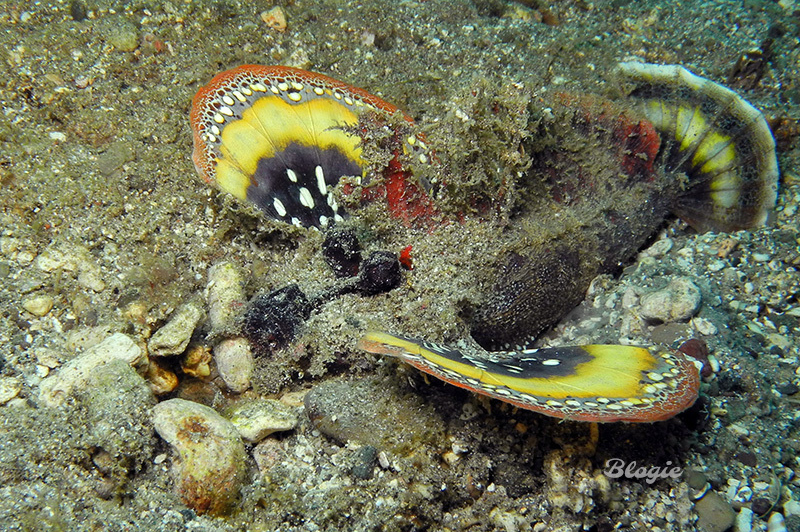Longsnout Stingerfish, Inimicus didactylus (Pallas 1769)

A Longsnout Stingerfish, Inimicus didactylus, at Samal Island, Philippines, October 2011. Source: Blogie Robillo / iNaturalist.org. License: CC By Attribution-NonCommercial-NoDerivatives
A well-camouflaged stingerfish with a dark inner surface to the pectoral-fin, a pale band on the outer half and a reddish fin margin. The free lower pectoral-fin rays are used as 'walking legs'. This nocturnal predator often lies partly-buried and is easily overlooked by divers. Stingerfish have highly venomous spines, and may cause very painful wounds.
Video of several male Longsnout Stingerfish vying for the attention of a female.
Longsnout Stingerfish, Inimicus didactylus (Pallas 1769)
More Info
|
Distribution |
Known in Australian waters from Shark Bay, Western Australia, to Cape York, Queensland, and possibly further south. Elsewhere the species occurs in the tropical east-Indo-west-Pacific. Inhabits sandy and muddy bottoms in 0-80 m, often lying partly buried. |
|
Features |
Dorsal fin XV-XVII, 7-9; Anal fin II, 10-12. Lower two pectoral-fin rays are entirely free from the membrane, and are used as "walking" legs. |
|
Colour |
Highly variable to match surroundings and is best identified by the brightly-colored pattern on the inner surface of the pectoral fin which has a dark base and a dark margin. |
|
Feeding |
Carnivore - feeds on small fishes and crustaceans. |
|
Fisheries |
Of no interest to fisheries, although occasionally taken as by-catch in commercial trawls. |
|
Remarks |
The dorsal-fin spines are highly venomous and may cause very painful deep wounds. Species of Inimicus flash the bright colour pattern on the inner surface of the pectoral fin during courtship displays and to startle predators. |
|
Similar Species |
The Longsnout Stinger differs from the other two species found in Australia in having a dark base, a pale middle band, and a reddish margin on the inner surface of the pectoral fin. The Demon Stinger, Inimicus caledonicus, has two dark bands and a pale margin on the inner surface, and the Spotted Stonefish, I. sinensis, has a dark inner surface with white to yellow spots and blotches. |
|
Species Citation |
Scorpaena didactyla Pallas, 1769, Spicilegia Zoologica 1(7): 26, pl. 4, figs. 1-3. Type locality: Indian Ocean (probably Indonesia). |
|
Author |
Bray, D.J. 2018 |
|
Resources |
Longsnout Stingerfish, Inimicus didactylus (Pallas 1769)
References
Allen, G.R. 1997. Marine Fishes of Tropical Australia and South-east Asia. Perth : Western Australian Museum 292 pp. 106 pls.
Allen, G.R. & Erdmann, M.V. 2012. Reef fishes of the East Indies. Perth : Tropical Reef Research 3 vols, 1260 pp.
Allen, G.R. & Swainston, R. 1988. The Marine Fishes of North-Western Australia. A field guide for anglers and divers. Perth, WA : Western Australian Museum vi 201 pp., 70 pls.
Eschmeyer, W.N., Rama-Rao, K.V. & Hallacher, L.E. 1979. Fishes of the scorpionfish subfamily Choridactylinae from the western Pacific and the Indian Ocean. Proceedings of the California Academy of Sciences 41(21): 475-500 figs 1-10
Fricke, R., Kulbicki, M. & Wantiez, L. 2011. Checklist of the fishes of New Caledonia, and their distribution in the Southwest Pacific Ocean (Pisces). Stuttgarter Beiträge zur Naturkunde. Serie A (Biologie) Neue Serie 4: 341-463
Gloerfelt-Tarp, T. & Kailola, P.J. 1984. Trawled Fishes of Southern Indonesia and Northwest Australia. Jakarta : Dir. Gen. Fish. (Indonesia), German Tech. Coop., Aust. Dev. Ass. Bur. 406 pp.
Kuiter, R.H. & Tonozuka, T. 2001. Indonesian Reef Fishes. Part 1. Eels- Snappers, Muraenidae - Lutjanidae. Australia : Zoonetics pp. 1-302.
Myers, R.F. 1999. Micronesian Reef Fishes. A comprehensive guide to the coral reef fishes of Micronesia. Guam : Coral Graphics vi 330 pp. 192 pls.
Pallas, P.S. 1769. Spicilegia Zoologica, quibus novae imprimus et obscurae animalium species iconibus, descriptionibus atque commentariis illustrantur. Berlin Tom. 1 Fasc. 7 42 pp. 6 pls.
Poss, S.G. 1999. Families Scorpaenidae, Caracanthidae, Aploactinidae. pp. 2291-2358 in Carpenter, K.E. & Niem, T.H. (eds). The Living Marine Resources of the Western Central Pacific. FAO Species Identification Guide for Fisheries Purposes. Rome : FAO Vol. 4 2069-2790 pp.
Randall, J.E. 2005. Reef and shore fishes of the South Pacific. New Caledonia to Tahiti and the Pitcairn Islands. Honolulu : University of Hawaii Press 707 pp.
Randall, J.E., Allen, G.R. & Steene, R. 1997. Fishes of the Great Barrier Reef and Coral Sea. Bathurst : Crawford House Press 557 pp. figs.
Rifkin, J & Williamson, J. 1996. Venomous fish. in Williamson, J.A., Fenner, P.J., Burnett, J.W. & Rifkin, J.F. (eds). Venomous and poisonous marine animals : a medical and biological handbook. Surf Life Saving Australia and Sydney: University of New South Wales Press Ltd, 800 pp.
Sutherland, S.K. & Tibbals, J. 2001. Australian animal toxins: the creatures, their toxins and the care of the poisoned patient, 2nd ed. Melbourne: Oxford University Press.









